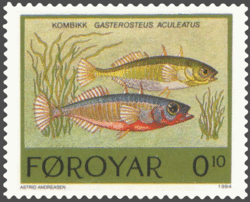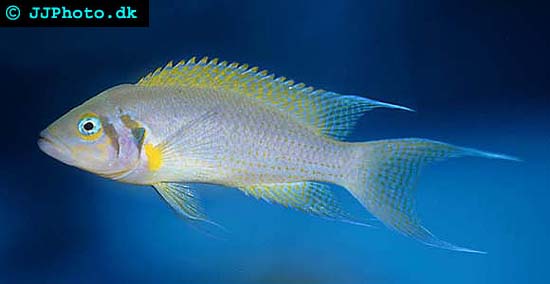Tag Archives: male
Male Fish Won’t “Ask For Directions”
Recent research has come to the astonishing conclusion that fish, specifically the males, positively refuse to ask for directions when they are breeding.
A recent research project, by the University of St. Andrews, has found that male fish seem to become more anti-social feeders, becoming even more so when they are ready to spawn.
As a result of this, they put themselves in greater peril, by leaving the shoal behind.
The claim is being made by researchers in charge of the project that this is one of the first studies performed that has shown a differences in the sexes when it comes to how animals learn from one another.
The current belief is that this trait is only seen in male fish when they are getting ready to spawn or are spawning, and may correlate to the distinct pressures faced by the sexes when spawning.
The research was conducted by Dr. Mike Webster and Professor Kevin Laland, whose goal was to take a look at the copying and learning behaviors of ninespine stickleback.
It appears the males tend to look for food reserves on their own, so that they can properly protect their young when the time comes, and this is why they don’t feed together.
Dr Webster added: “We are all familiar with the stereotype of males refusing to ask for directions – this might apply to fish too, but only when they are preparing to breed.”
“Perhaps part of the reason the males are so likely to cheat is that females never punish males”,
“Perhaps part of the reason the males are so likely to cheat is that females never punish males”, marine scientist says.

The Bluestreak cleaner wrasse (Labroides dimidiatus) lives on coral reefs where it feeds by removing parasites and dead tissue from the skin of larger fish. Most of the time the wrasse provides bigger fish with a valuable service, but sometimes the tasty mucus in front of the cleaner turns into an irresistible temptation, prompting the wrasse to bite off a mouthful. This is naturally not appreciated by the bigger fish and a cleaner wrasse who can’t control his or her urges will have to watch the big fish take off in a jiffy, taking all the nutritious parasites with it.
When a male fish notice a female fish scaring off the big fish they are cleaning together he will promptly punish her for her injudiciousness. This might seem altruistic, but the male fish is actually pissed off at her for making his dinner swim away.
“The male’s dinner leaves if the female cheats,” says Nichola Raihani from the The Zoological Society of London who has been studying Labroides dimidiatus together with research partner Redouan Bshary.
“By punishing cheating females, the males are not really sticking up for the clients but are making sure that they get a decent meal,” Raihani explains.
Raihani believes true altruism is rare.
“When you see something that looks like it’s altruistic, if you look hard enough, there’s normally going to be a benefit somewhere down the line for the person that’s doing that supposedly altruistic act,” she says.
Interestingly enough, a female fish that has to watch her dinner swim away because a male wrasse couldn’t leave the mucus alone never punishes the culprit.
“The males are less well behaved than the females a lot of the time but perhaps part of the reason the males are so likely to cheat is that females never punish males,” Dr Raihani told the Science podcast.
Males tend to be larger than females and this might be why the female finds it safer not to discipline him. All Bluestreak cleaner wrasses start out as females and in a group of 6-8 wrasses you will never find more than one male. If the male dies or is removed from the group, the strongest female will change into a male and take his place.
The wrasse study has been published in the journal Science.
You can download the podcast here: http://podcasts.aaas.org/science_podcast/SciencePodcast_100108.mp3
The nanny effect
In several species of fish, such as the cichlid species Neolamprologus pulcher, it is common for subordinate females to help an unrelated dominant breeding pair raise their young. The reason behind this seemingly altruistic behaviour, known as alloparental care, has puzzled scientists for many years and one of the most widely spread hypotheses put forward has been the ‘pay-to-stay’ hypothesis. According to the ‘pay-to-stay’ rationale, the subordinate female helps out the dominant pair just to be able to stay in the group. Not being ostracised from the group augments her long-term survival chances, thus increasing the chance for her to live long enough to eventually obtain a breeding position.
Picture by: JJPhoto.dk
A new study carried out by Dik Heg and coauthors does however bring forth a new hypothesis: the substrate rationale. In their study, Heg and his colleges tested the hypothesis that subordinate female cichlids are helping dominant pairs in return for a more immediate direct reproductive benefit. After a series of experiments where the total number of eggs produced over a 30 day period by dominant and subordinate Neolamprologus pulcher females were carefully counted, researchers found that a subordinate female helping out a dominant pair was more likely to produce eggs herself compared to other subordinate females.
According to Heg and coauthors, the most likely reason for the increased reproductive success of “fish nannies” is that the subordinate female gains access to the breeding substrate.
If you wish to read more, see the paper “Heg, D, E Jutzeler, JS Mitchell and IM Hamilton (2009) Helpful female subordinate cichlids are more likely to reproduce”. It has been published in the journal PLoS ONE.
Here at AC Tropical Fish, we believe in the Jude Law-hypothesis. The dominant female will naturally snatch away the most prosperous male, but by posing as a benevolent nanny even a subordinate female can gain access to his home and hope for some of his triumphant DNA to eventually find its way into the genetic make up of her own offspring.
Changing gender – a question of survival
Zoology Prof. Yossi Loya at the Tel Aviv University in Israel has discovered that corals changes sex to survive periods of stress, such as high water temperatures. By observing the behaviour of Japanese sea corals he discovered that stressed female mushroom coral (fungiid coral) change gender to become males, and that male corals are much better at handling stress and fare better at surviving on limited resources. Not all females go through his change but many do and most of the population is therefore male during periods of intense stress.
Yossi Loya says: “We believe, as with orchids and some trees, sex change in corals increases their overall fitness, reinforcing the important role of reproductive plasticity in determining their evolutionary success. One of the evolutionary strategies that some corals use to survive seems to be their ability to change from female to male, As males, they can pass through the bad years, then, when circumstances become more favourable, change back to overt females. Being a female takes more energy, males are less expensive to maintain. They are cheaper in terms of their gonads and the energy needed to maintain their bodies. Having the ability to change gender periodically enables a species to maximize its reproductive effort.”
Loya’s discoveries have been published in the Proceedings of the Royal Society B. The professor hopes that this new knowledge will help coral farmers by allowing them to reproduce the hardy Fungiid corals more effectively.
Loya has been studying coral reefs for more than 35 years and won the prestigious Darwin Medal for a lifetime contribution to the study of coral reefs. He is also involved in coral rehabilitation projects in the Red Sea and is a professor at the Tel Aviv University in Israel.
Single moms have bigger brains
In a new study on Tanganyika cichlids, three scientists[1] [2] [3] from Uppsala University in Sweden have shown that intricate rearing behaviour varies with brain size in females. The only previously published study showing similar patterns concerned predatory animals.
Tropheus moori – one of the species used in the study. – Picture www.jjphoto.dk
How the vertebrate brain has developed throughout the course of evolution is still not clear, and we are still not certain if brain functions in a specific species develop to match a demanding environment. One way of learning more about this is to compare brain size and structure in closely related species living under dissimilar circumstances.
“It is important to look at differences between males and females since females often distinguish themselves from males, both in behaviour and appearance”, says Niclas Kolm, lead-author of the study.
The study looked for correlations between brain size and ecological factors in a large number of specimens from 39 different species of Tanganyika cichlid. Lake Tanganyika is especially suitable for this type of study since it is inhabited by cichlid groups exhibiting significant dissimilarities in both brain structure and ecology, and whose ancestry is well known. Tanganyika cichlids varies dramatically from species to species when it comes to factors such as body size, diet, habitat, parental care, partner selection, dissimilarities between the sexes, mating behaviour, and brain structure.
The result of the study showed a correlation between brain size and the two factors diet and parental care behaviour. Species where only the female fish cares for egg and fry turned out to have bigger brains than species where both parents engage in parental care. The brain was however only larger in females; there was no difference in brain size between males of the two groups.
The largest brains of all were found in algae-eating cichlids. These fishes live in environments characterized by a high level of social interaction. “This indicates that social environment have played a role in brain development”, says Kolm.
The study was published in the web version of “Proceedings of the Royal Society of London Series B” on September 17. You can find it here (http://journals.royalsociety.org/content/j114062824820l76/).
[1] Alejandro Gonzalez-Voyer, Animal Ecology, Department of Evolutionary Biology, Evolutionary Biology Centre, Uppsala University
[2] Niclas Kolm, Animal Ecology, Department of Evolutionary Biology, Evolutionary Biology Centre, Uppsala University
[3] Svante Winberg, Department of Neuroscience, Physiology Unit, Biomedical Centre (BMC), Uppsala University


